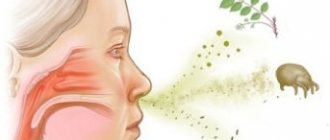Nasal congestion due to allergies: how to eliminate inflammation?
Allergic rhinitis occurs quite often in patients.
The disease is not contagious, but its symptoms are almost the same in all people. Nasal congestion is caused by the action of allergens, which provoke an inflammatory process in the mucous membrane. According to statistics in the Russian Federation, approximately 20% of the total population suffers from nasal congestion due to allergies. The main source of inflammation is the body's immediate reaction to exposure to irritating microparticles. Allergic processes manifest themselves so quickly that sometimes just a few seconds are enough for a person to experience inflammation in the nasal cavity after contact with an allergen.
Allergies can be caused by many triggers:
- Insects (after a bite)
- Pollen from flowering plants (herbs, flowers, trees)
- Mites that live in household dust, beds
- Mold or yeast
- Products
- Medicines
In some patients, allergic rhinitis occurs due to several irritants, in others - only through one type of allergen. In most cases, people who have close relatives suffering from allergies also experience symptoms of the disease.
Treatment
In order to begin treatment with the ASIT method, it is necessary to exclude contact with the allergen. In the case of seasonal rhinitis due to plant pollen, you can get rid of the allergen by moving to another area.
For you: Features of the clinical picture of autoimmune hepatitis
But this, nevertheless, is not a solution due to the possibility of cross-allergy and the risk of a reaction to another plant.
Antihistamines
A way to cope with a runny nose is to take antihistamines, which must be done strictly following the instructions, paying attention to the dosage of the medicine and possible side effects.
It must be remembered that almost all antihistamines have a calming effect. Of course, the latest generation of drugs cause drowsiness after administration to a lesser extent than Suprastin or Diazepam, however, when treating allergies, you should refrain from driving or participating in sports competitions.
Decongestants
It is better not to get carried away with vasoconstrictor nasal drops for allergic rhinitis. Sometimes, with a runny nose, not knowing about its allergic origin, they actively use only fast-acting Nazivin drops (active ingredient oxymetazoline), which should not be done if you have allergies.
The fact is that Nazivin cannot be used for a runny nose for more than 5 days, as manufacturers warn about in the instructions for use. But, since a runny nose or sinusitis can last for weeks or months, patients use Nazivin for too long.
In such situations, the blood vessels lose the ability to narrow on their own, and nasal breathing returns only after the next instillation of the decongestant.
How to recognize that nasal congestion is due to allergies?
There are several main symptoms by which nasal congestion of an allergic nature can be distinguished from a viral or bacterial runny nose. Mostly, patients are concerned about the following signs of the disease:
- Paroxysmal sneezing (a person sneezes many times in a row without stopping and regardless of the presence of certain irritating factors)
- Itching in the nose, sometimes burning (this symptom occurs immediately and continues until the end of the allergic reaction)
- Difficulty breathing, worsening at night
- No fever
In addition, by the appearance of the patient, one can understand that he has allergic nasal congestion. For example, usually red spots, swelling, and conjunctivitis form on the patient’s face in the area of the wings of the nose and eyes. Most often, the eyes water, so the capillaries are very pronounced. In most cases, due to itching, patients involuntarily rub the tip of their nose, so it also becomes red and skin irritation becomes noticeable.
Allergic rhinitis begins to appear in childhood, sometimes developing during puberty due to hormonal changes. The intensity of the symptoms determines the degree of allergy:
- Mild (observed in patients who practically do not feel any special changes in the body, symptoms do not affect sleep or activity during the day)
- Medium (classifies allergy symptoms that disrupt sleep and reduce performance)
- Severe (all symptoms are pronounced and occur with great intensity)
If allergic nasal congestion occurs only periodically and is associated with flowering vegetation, then it is called seasonal rhinitis or hay fever. When allergy symptoms appear constantly, then it is year-round.
Typically, patients with allergic rhinitis are very sensitive to strong odors, such as cleaning chemicals, tobacco smoke, perfumes, etc.
Despite the fact that allergy symptoms can be recognized independently, you should still diagnose the body so as not to miss the development of other types of rhinitis. Similar symptoms occur in hormonal, occupational and even atrophic rhinitis. Therefore, it is best to consult an allergist to establish an accurate diagnosis.
What to do if you have a stuffy nose
If a runny nose occurs for the first time, then no one except an allergist can help you choose the right treatment. Discomfort with an allergic rhinitis can be so strong that the patient loses his ability to work, cannot sleep or eat.
You cannot diagnose yourself. The best thing to do first is to visit a doctor. No folk or home treatment will help cope with allergies.
Allergic rhinitis occurs as:
- seasonal , occurring periodically - allergy to pollen;
- permanent – reaction to house dust, wool.
Drugs that are used for allergic rhinitis are prescribed according to the general scheme for both adults and children. The only difference is in the dose of the drug, and also in the fact that some drugs are not prescribed to children due to the high risk of side effects. Drugs are prescribed with increased caution during pregnancy.
And if congestion is caused by allergic sinusitis, then congestion without a runny nose is possible. This phenomenon occurs when secretive inflammation in the maxillary sinuses periodically worsens.
Drugs for the treatment of runny nose
To eliminate the symptoms of allergic nasal congestion, medications from several groups are used.
- Antihistamines – Cetirizine, Clemastine, Loratadine;
- mast cell stabilizers – sodium cromoglycate;
- hormonal agents acting locally - Fluticasone, Beclomethasone;
- acetylcholinergic drugs – Ipratropium bromide;
- vasoconstrictors – Oxymetazoline, Naphazoline, Xylometazoline;
- leukotriene antagonists - Montelar.
Allergy treatment begins after all signs of allergic rhinitis disappear. And the only way to treat allergies is allergen-specific immunotherapy (ASIT).
How is allergic rhinitis diagnosed?
Firstly, if signs of a runny nose appear, you need to contact two specialists at once: an ENT specialist and an allergist-immunologist. This is necessary in order to prevent the development of combinations of problems, for example, allergic rhinitis and sinusitis.
To identify allergens, a smear is taken from the nasal cavity for eosinophils. Blood is also taken to determine IgE-specific. But this examination method does not always show accurate results and its cost is quite high.
A more informative diagnostic method is skin testing. To carry it out, scratches are made on the patient's skin and various allergens are applied to microscopic wounds. After 30 minutes, you can determine which stimulus the body reacts negatively to. Skin tests are not performed during pregnancy or during an exacerbation of the disease. In order for the diagnostic results to be correct, do not take antiallergic medications for 7 days before the procedure.
If additional examination is required, the ENT may prescribe x-rays of the paranasal cavities and rhinomanometry to assess nasal congestion.
How dangerous is allergic rhinitis?
Not all patients believe that nasal congestion due to allergies is a serious symptom. But this opinion is erroneous, because without treatment or with the wrong selection of treatment methods for allergic rhinitis, patients can develop dangerous complications:
- Purulent sinusitis (most often the maxillary cavities are affected)
- Otitis
- Conjunctivitis (occurs in 50% of patients)
- Decreased ability to work
- Bronchial asthma
Treatment of allergies should be carried out using effective methods and it is recommended to begin eliminating the symptoms of rhinitis at the initial stage of development of inflammation. In addition, it will be possible to cure an allergic runny nose only if you identify the irritant allergen and limit contact with it as much as possible.
Why does a child or an adult have a stuffy and swollen nose due to allergies?
Seasonal runny nose occurs due to such exposure of the mucous membrane covering the nasopharynx and the negative influence of one or another allergen with the addition of an irritating effect. It is important to know that swelling of the nose due to allergies occurs not only during the flowering time of the corresponding plants, but also with a number of other factors that are relevant all year round. The latter are associated with the presence of:
- pet hair and dander;
- cuticle particles of indoor parasites, such as bedbugs or cockroaches;
- dusty coating on furniture and mold in damp corners;
- certain foods and medications;
- chemicals to kill pests.
Why exactly the swelling has formed will be determined by a specialist. He will prescribe to carry out appropriate tests, which will accurately indicate the irritant - the provocateur of this kind of reaction in the body.
This disease often affects children. In this case, two reasons contribute to the pathology - an immature immune system or excessive indiscriminate use of vasoconstrictors. Therefore, it is extremely important to take the treatment of respiratory diseases under personal control of parents, without giving medications without medical advice.
Treatment of allergic rhinitis
Patients with allergies are seen by an allergist-immunologist. Each patient is individually prescribed a comprehensive treatment program. In modern medical practice, doctors use ASIT, that is, allergen-specific immunotherapy. This method allows you to eliminate many symptoms of rhinitis, including bronchial asthma. Treatment makes it possible to increase the period of remission and reduce the number of antihistamines taken. Using ASIT at the initial stage of disease development, it is possible to prevent complications of its course.
During the acute course of an allergic rhinitis, a specialist prescribes safe and fast-acting medications. The most effective is considered to be a new generation drug, which is characterized by low toxicity and the absence of side effects.
If a patient has a moderate or severe allergic rhinitis, he must be prescribed anti-inflammatory therapy. Such drugs include drugs with hormonal components for intranasal administration. They are selected according to the individual characteristics of each patient. As a rule, allergic rhinitis is treated by an ENT specialist. The anti-inflammatory drug quickly relieves nasal congestion and is superior in action to antihistamines.
Allergic reactions of mild and moderate course require the use of antiallergic medications. They are prescribed for oral use. Second- and third-generation drugs are popular in the pharmaceutical market. These include Zodak, Claritin, Zyrtec, Telfast, etc. Treatment lasts approximately 14 days, but the exact duration of therapy must be determined by the doctor.
Antihistamines can have negative effects on patients' bodies. Therefore, if a child develops nasal congestion due to allergies, a pediatrician should prescribe a course of treatment and certain medications. Frequent side effects of antiallergic drugs are depression of the cardiovascular and nervous systems. In addition, antihistamines can negatively affect the mental abilities of a child or adult.
For nasal congestion and runny nose, topical medications are used, such as Cromohexal, Cromoglin, etc. Spray products can be used to treat childhood allergic rhinitis or at the initial stage of the disease. They are prescribed as a preventive measure for year-round allergies.
Currently, a drug such as Nazaval is popular. It is able to form a protective film on the nasal mucosa, preventing contact of the allergen with the membrane. If the patient has severe rhinitis, the specialist may prescribe powerful nasal corticosteroids, such as Nasonex, Flixonase, Benorin, etc.
When drug treatment does not produce positive results, the doctor prescribes allergen-specific immunotherapy. If the patient has concomitant ENT pathologies, deviated septum or other abnormal structural abnormalities of the nasal cavity, then the specialist may recommend surgical intervention. Now it is possible to carry out bloodless operations using radio waves, cryosurgery, electrosurgery, and laser.
Following your doctor’s recommendations will help minimize the symptoms of allergic rhinitis or get rid of the disease for life. At home, you can only use saline solutions to rinse your nose, because there are no effective treatments in traditional medicine.
Source: zalozhen-nos.ru
How to quickly relieve nasal congestion - drops and sprays
When the nose is stuffy, a person experiences a lack of oxygen, so special drops are indispensable. How to relieve swelling in the nose due to allergies, your doctor will tell you. All drugs of this kind can be divided into vasoconstrictors and moisturizers. The former are more common; these are aerosols and droplets. Moreover, sprays are better suited for adults, and droplets are better for children.
When using such products, the nasal mucosa narrows, thereby reducing the swelling of the nasal cavity, the volume of mucus and the rate of its formation.
The main means for relieving congestion are:
- Nazivin, which facilitates nasal breathing due to the presence of oxymetazoline. Its purpose is for patients with rhinitis, sinusitis, ARVI, as well as in preparation for diagnostic procedures. It is important to determine the appropriate dosage for children and adults;
- Nazol, which can treat a runny nose due to acute rhinitis. Moreover, the remedy is effective after the first signs of the disease appear, thanks to oxymetazoline hydrochloride. Pregnant women, young children, and those who are allergic to the components should avoid it.
- Sanorin is recommended for severe nasal congestion and acute rhinitis. These drops should not be taken in parallel with antidepressants; otherwise, there is a risk of a strong jump in blood pressure.
- Tizin is known for its rapid action - within 5-10 minutes, it is effective for the treatment of all manifestations of rhinitis, sometimes pharyngitis and sinusitis.
- Xylometazoline, which can be distributed even in the form of an ointment. Its component of the same name also reduces the amount of mucus and relieves swelling, and begins to act within a couple of minutes.
As for moisturizing drops, they also remove the signs of the corresponding symptoms. Their main quality is quick removal of mucus and an effective healing effect. The mucous membrane maintains its integrity and health.
The most famous means of this kind are:
- Aquamaris, which is based on sterile water with favorable ingredients for the functioning of the nasal mucosa. It quickly removes mucus, which becomes thinner. The product is indicated even for children.
- Aqualor, made from sea water, the mineral components of which reduce infectious secretions and thick mucus.
- Marimer is also good for facilitating mucus removal and mucosal restoration. But since the product contains an antibiotic, it is unacceptable for infants and women in the last months of pregnancy.
- It treats a runny nose well and moisturizes excessively dry mucous membranes and salin. True, the drug also has contraindications for those with cerebral edema and those suffering from renal failure.
Thus, there is a whole scattering of drops and sprays against nasal congestion; you just need to be aware of the indications and side effects and make a choice in favor of the most effective one for you.
How to distinguish the allergic cause of nasal congestion
In order to reliably determine what is the cause of nasal congestion: a cold, dysregulation of vascular tone, or a foreign allergen protein, it is necessary to monitor the patient’s well-being in various environmental conditions. You need to find out how he feels at different times of the year in nature, on the street, at home. In this situation, in the absence of an allergen and/or when taking antihistamines, nasal breathing is restored, swelling of the mucous membrane goes away and relief occurs.
Causes of nasal congestion
There are several causes of nasal congestion:
- neoplasms in the nasal cavity;
- onset of ARI;
- polyps;
- chronic infection of the mucous membrane. This often happens in people who work in conditions that increase the risk of developing allergies;
- allergic reaction;
- adenoids;
- vasomotor rhinitis;
- reaction to taking certain medications;
- sinusitis;
- bacterial infection of the nose.
Nasal congestion due to allergies (allergic rhinitis)
Nasal congestion due to allergies is fundamentally different from any other type of runny nose. Vasomotor allergic rhinitis can be determined by the following signs:
- swelling of the nasal mucosa may be accompanied by itching, frequent sneezing and even coughing;
- Gradually, the congestion is accompanied by the release of mucous contents (snot), which usually has a watery consistency and is colorless;
- a feeling of soreness in the nose may develop;
- An additional symptom is redness and itching of the eyes.
Allergies can be either seasonal (hay fever) or year-round. A variety of substances can trigger allergic rhinitis. There are many classifications of allergies.
Most often, congestion of this nature is observed in patients suffering from a reaction to pollen and animal hair.
Stuffy nose due to allergies: allergens present “incognito”
Allergic nasal congestion is a collective concept that includes hay fever (seasonal rhinitis associated with dust from causative plants), as well as a runny nose, which can develop for no apparent reason. Following the established stereotype, the average person, far from medicine, believes that if the nose is stuffy, allergies or hypersensitivity of the body are present only upon contact with allergens in the inhaled air. However, allergists have made appropriate adjustments to the list of causative factors.
- If there is an allergy to animal fur, some lovers of four-legged pets get cats and dogs of a hairless breed. But few people know that dead particles of animal skin, which are lost in huge quantities every day, are identical in composition to fur, that is, they can also cause nasal congestion.
- If a person has trouble breathing through the nose from time to time or has bouts of unreasonable sneezing or watery eyes, it is necessary to find out what triggers this condition. To do this, experts recommend keeping a special diary and recording in it everything that was eaten and drunk the day before, what cosmetics were used and where exactly the outdoor walk took place. It is also imperative to record the date and time of each case of nasal congestion. As a rule, after a few weeks a person will definitely discover the true culprit of his condition. This could be one or another food product, cosmetic product, home or park plant, etc.
- If the cause of the development of an allergy was a substance that was previously absolutely harmless, then, most likely, the person at one time did not pay due attention to the problem that arose. As a result, the body's sensitization has increased, and new ones have been added to the list of existing allergens. To stop the development of the pathological process, it is necessary to begin immediate adequate treatment. Otherwise, the amount of allergen in the body will sooner or later reach a critical level, and then a stuffy nose will become the most insignificant problem compared to the rest.
How to properly treat a stuffy nose due to allergies
Treatment of a runny nose of allergic origin should be prescribed by a specialist. It will take a long time to treat nasal congestion and other manifestations of allergic rhinitis, using a treatment regimen developed by a doctor strictly individually.
Allergy treatment is not only long, but also complex. Modern science is developing more and more new methods to get rid of allergies forever, acting on both the cause of the disease and its pathogenesis. Currently, allergic rhinitis should be treated in several directions simultaneously.
First of all, in order to relieve all allergy symptoms forever, it is necessary to completely eliminate human contact with the allergen. Another radical treatment method is desensitization of the body, that is, changing its response to an antigen. This path may take several years.
More often in therapeutic practice, in the presence of a detailed clinical picture of allergic rhinitis, symptomatic treatment is used. It consists in the use of medications that act on various mechanisms of allergy. These include vasoconstrictors, antihistamines, hormonal, barrier drugs and mast cell stabilizing agents.
To reduce swelling of the mucous membrane and get rid of nasal congestion, vasoconstrictor drugs are used. Their choice should remain with the doctor, since the wrong dosage or duration of the course can cause harm. The required drug (Galazolin, Rinorus, Afrin, Tizin) is selected according to the duration of action (short, medium or long) and is used for no more than 5 days in children and 7 days in adults.
Treatment of congestion of allergic origin is impossible without the use of antihistamines. Levocabastine or Allergodil sprays prevent the development of allergies by blocking histamine, binding to cellular receptors instead.
Hormonal drugs also occupy an important place in the treatment regimen. Having an anti-inflammatory and mucosal restorative effect, Nazarel, Nasonex, Flixonase are prescribed in individual courses, strictly under medical supervision.
We must not forget that corticosteroid drugs in the form of nasal sprays have a negative effect on local immunity. Barrier drugs (Prevalin, Nazaval) and stabilizers (Cromoglin, Cromohexal) necessary for treatment additionally strengthen and restore the epithelial layer, creating a protective film on its surface.
It is necessary to treat nasal congestion of allergic origin using simultaneously means of different directions. Only complex and long-term therapy will have a lasting positive effect on allergic rhinitis and help to get rid of nasal congestion for a long time.
Nasal congestion due to allergies
Allergy swelling of the nose is a common symptom of an allergic reaction to an irritant. With allergic rhinitis, the first thing a person experiences is a stuffy nose, discharge in the nasal cavity becomes abundant, and tears flow. With allergic rhinitis, sometimes there is only nasal congestion without a runny nose. An allergen can be anything: dust, animal hair, pollen, household chemicals, food. The severity of the allergic reaction depends on the individual characteristics of the body and the strength of the immune system.
Diagnostic specifics
With allergic rhinitis, signs of a runny nose develop without fever. A characteristic sign of the disease is breathing through the mouth with blocked nasal passages, with the situation worsening during night sleep. On the face of an allergy sufferer, you can find redness under the eyes due to constant lacrimation and in the area of the wings of the nose due to frequent wiping of current discharge.
For you: Causes of allergies in adults and children
If indirect signs of allergic nasal congestion are detected, you should consult a doctor (ENT or allergist), since allergic rhinitis is often accompanied by sinusitis. To diagnose pathology, taking into account the patient’s interview, the following actions are necessary to confirm the diagnosis:
- elucidation of the characteristics of the development of the disease and accompanying symptoms;
- visual examination of the nasal cavity;
- determination of the level of eosinophils, as well as IgE immunoglobulins.
The main informative method for diagnosing allergies is skin testing with the application of various allergens to the skin. The procedure allows you to determine the body's reaction to a specific stimulus. One of the methods for diagnosing the allergic nature of nasal congestion can be antihistamines. If taking them relieves symptoms, it can be argued that the cause of the runny nose is an allergy.
Nasal congestion due to allergies: treatment in adults
Treatment of allergic rhinitis includes a whole range of drugs: nasal glucocorticosteroids, systemic and local antihistamines, vasoconstrictors and other drugs. However, treatment will be incomplete without products containing sea water, which moisturizes the mucous membrane, helps wash away allergens from the nasal mucosa, and also relieves swelling.
If you have allergies, your nose is stuffy, but you don’t know how to relieve the swelling? The first aid will be to rinse the nasal cavity to ensure the removal of excess secretions and the removal of the allergen. Drugs from the Aqualor line can be used both as a remedy for nasal congestion due to allergies, and in complex treatment. They are suitable for children of all ages and even nursing mothers. For example, Aqualor Extra Forte will help cope with sinusitis during pregnancy. Sea water contained in Aqualor products helps relieve swelling, mechanically washes away dust and allergens, and increases the protective ability of the nasal mucosa.
Drugs for adults
You can relieve nasal congestion due to allergies in adults using exactly the same drugs as in children, but in higher dosages. Thus, phenylephrine is included in the composition of Nazol drops. Hormonal drugs for persistent edema and drugs containing sea water are also indicated. In adults, the range of anticongestants that can be used is much wider. So, you can prescribe “Sanorin”, “Naphthyzin”, “Galazolin”. These drugs are short-acting and provide relief for 2–3 hours, but it is not recommended to instill them for more than 2–3 days.
Allergy medications for nasal congestion in adults should not contain antibiotics. The fact is that drugs such as Isofra, Polidexa and others help in situations where a viral “cold” and rhinitis has given way to a bacterial one, and nasal mucus has become purulent.
In the case of an allergic reaction, antibiotics are not only useless, but also harmful, since they are inevitably swallowed and can cause intestinal dysbiosis. Drops for nasal congestion due to allergies can also be antihistamines.
For example, drugs such as:
- "Zodak". These drops are taken orally (rather than dripped into the nose), their effect develops 20 minutes after administration;
- Allergodil and Fenistil drops are also “fast-acting drugs”;
- Zyrtec. These antiallergic drops have one feature - they help with cold allergies, when swelling of the mucous membrane is provoked not by a cold, but by exposure to cold air.
- Among the folk remedies for nasal congestion, in addition to rinsing with salt water, instilling freshly squeezed aloe juice and living wood, you can use fresh black currants, which can be eaten fresh, mixed with sugar.
Thus, allergies and nasal congestion are highly treatable. If the symptoms progress, difficulty breathing or suffocation develop, then you need to call an ambulance and not self-medicate.
Nasal congestion due to allergies: treatment in children
The child’s body is extremely fragile because it is in the stage of development and formation. If you are looking for a way to relieve nasal congestion due to allergies in your child, turn to natural remedies. The Aqualor Baby product line includes drops, spray and nasal aspirator. All these remedies can be used from the first days of a child’s life. Aqualor Baby contains only sea water, which includes ions of calcium, magnesium, iodine, selenium and others.
Therefore, if a child has allergies, a stuffy nose, and you don’t know what to do, then start by moisturizing the mucous membrane and rinsing the nose. Aqualor Baby contains a special nozzle that provides delicate irrigation of the mucous membrane and rinsing of the nasal cavity. The restrictive ring of the nozzle will protect against injury to the delicate baby mucosa.
Runny nose and nasal congestion due to allergies: how to deal with it?
A stuffy nose is a very unpleasant and even dangerous phenomenon. Most often, this symptom occurs with a cold. However, very often a runny nose appears as a sign of an allergy.
Allergic rhinitis occurs as a result of exposure to various allergens. This is a very common problem, occurring in 20% of the entire population.
To get rid of this unpleasant symptom, it is necessary to find out its nature and characteristics.
What is allergic rhinitis?
Allergic rhinitis is a disease caused by exposure of the nasal mucosa to various allergens. This is not a contagious disease and sometimes goes away as quickly as it appears. But in order to select methods of control, it is necessary to find out the allergen.
A stuffy nose can occur as a result of microparticles entering it:
- Dust;
- Plant pollen;
- Household chemicals;
- Dust micromites;
- Fungal formations;
- Animal fur.
These elements cause swelling of the nasal cavity and, as a result, runny nose and sneezing.
How to distinguish allergic rhinitis from a cold
The difficulty of treating allergic rhinitis is that it is often confused with a cold and is actively treated. However, such therapy is ineffective; conventional cold remedies do not help.
Before starting treatment, it is necessary to find out the type of runny nose. Allergic rhinitis has distinctive features that you need to navigate:
- Features of discharge. With rhinitis, they are liquid, mucous, but very abundant, requiring frequent wiping. As a result, the skin around the nostrils and under the nose becomes inflamed.
- Sneezing. It occurs very often and loudly, such sneezing can cause irritation of the mucous membrane, and pain occurs.
- Edema. This symptom is observed on the nasal mucosa and nasopharynx. In case of severe nasal congestion, the entire face, eyes, and ears become swollen, and there may be pain in the ears when sneezing.
- Pain syndrome is felt in the nasal area; the greater the swelling, the more acute the pain.
- The development of conjunctivitis is inflammation of the mucous membrane of the eyes; redness may be accompanied by the release of purulent formations.
These signs distinguish a runny nose due to allergies from nasal congestion due to a cold. During treatment, it is also possible to distinguish between these two types: when warmed up, rhinitis does not disappear, no antibiotic drugs get rid of it. The discharge does not disappear after applying the drops, but only stops for a few minutes. Very quickly this condition becomes chronic, with seasonal exacerbations.
How is allergic rhinitis diagnosed?
If a person has been bothered by a runny nose for a long time and cannot cope with it on his own, he should consult a doctor. Problems of this type are dealt with by two specialists: an ENT specialist and an allergist.
To confirm the presence of an allergy, the following procedures are performed to determine the allergen:
- Skin tests. The most common and accurate diagnostic method. It is done in a simple way: scratches are made on the skin, then the allergen is dropped and the body’s reaction is studied.
- Enzyme immunoassay blood test - determination of specific immunoglobulins.
- A smear of the nasal mucosa for the presence of eosinophils.
- X-ray examination of the paranasal cavities (used as an additional method in controversial analyses).
If the diagnosis is confirmed, it is necessary to take action, but it is important to understand that allergies cannot be cured completely, you can only get rid of its manifestations and alleviate the symptoms.
Treatment of nasal congestion due to allergies
The main principle in treatment is to avoid contact with the allergen. If an allergy to plants is easier to survive, it comes in seasonal attacks, then an allergy to dust is more difficult.
In this case, it is necessary to vacuum the entire apartment every day, abandon carpets and things that collect dust.
Also, in such cases, it is not recommended to visit libraries and any places where there is a possibility of collecting dust.
In addition, it is necessary to select antihistamines that should be used during exacerbations. The most popular drug is “Calcium chloride”; it is an affordable product at a low cost.
There are also a number of other, stronger drugs available in the form of drops, aerosols and sprays.
When choosing, it is very important to pay attention to side effects, which often include drowsiness, lethargy, headache, and dizziness.
Do not overuse medications; frequent use of drops can cause dryness of the nasal mucosa and irritation.
There are also folk remedies for getting rid of allergic rhinitis. Traditional healers recommend using aloe juice: drop a few drops into each passage; such procedures can be done several times a day. Dandelion juice is also actively used. It is diluted with warm milk and dripped into the nose and one teaspoon is drunk before meals.
There are several other traditional methods of treatment, but they are not confirmed by science. Experts still recommend contacting them. If you have allergies, you cannot experiment; this disease progresses very quickly and can lead to complications.
Source: https://medportal.su/nasmork-i-zalozhennost-nosa-pri-allergii-kak-s-etim-borotsya/
Should you go to the doctor?
If you suspect an allergy, then you should go to the doctor to get tested and determine what exactly the allergen is. Neglected cases, when seasonal allergies turn into year-round rhinitis, create fertile ground for the emergence of new dangerous diseases or complications. By knowing what triggers your body's allergic reaction, you can limit your exposure to allergens. Only a doctor can prescribe prescription medication for you if needed.
What is allergic swelling of the nasal mucosa
As already stated, this is a response. Symptoms can vary greatly - from a common runny nose to asphyxia. Swelling of the nose due to allergies develops against the background of the release of antibodies designed to block allergens. This is the main difficulty: to understand what caused it. The symptoms can easily be confused with ARVI or a cold.
Swelling of the nasal mucosa ( allergies ) can be caused by various factors, which we will discuss below. The fragile immune system of children reacts especially strongly to them. In order to provide timely assistance, it is important to know how to relieve allergic swelling of the nose. Since this pathological condition does not occur on its own, but as a response to an external stimulus, it is important to consult a doctor and conduct a full diagnosis . Swelling of the nose due to allergies leads to the fact that the vessels located in the epithelial tissue undergo significant expansion.
When the body comes into contact with an allergen, histamine is released, which is a natural chemical that protects against the foreign protein. It is this that triggers allergic swelling of the nasopharynx and its constant symptoms, including runny nose, sneezing and itching.
That is, allergic rhinitis is caused by the immune system reacting to a new protein as if it were harmful. This causes the cells to release a number of chemicals that cause swelling and excessive mucus production. The reasons remain not fully understood today, but there is reliable, repeatedly verified data.
Oversensitive immune system
If you have allergic swelling (AR) of the nose , the immune system will react to foods that are natural to other people, pollen or dust, as if they were dangerous to the body.
- If the immune system is hypersensitive, it will react to all allergens by producing antibodies to fight them. As a result, harmless poplar fluff causes allergies and swelling of the nose .
- Antibodies are special proteins in the blood that are usually produced to fight viruses and infections. Now the immune system directs them to fight pollen, dust or something from food.
- Reactions do not occur upon first contact with the allergen. The immune system must recognize and “remember” the enemy before developing countermeasures. This process is known as sensitization.
- Once you develop sensitivity, nasal swelling and runny nose due to allergies will appear the first time you come into contact with a certain protein group.
This is what causes the typical symptoms of sneezing or runny nose. They are unpleasant, but do not cause fear for the patient's life.
Common allergens
In most cases, they turn out to be the reason why allergic swelling of the nose develops. Adequate treatment becomes possible only after the causes are established. And the reaction can be provoked by:
- House dust mites. These are tiny insects that live in the dust of dead flakes of human skin. They can be found in pillows and beds. Rhinitis is not caused by dust mites themselves, but by a chemical contained in their excrement. They live indoors year-round, although their numbers tend to peak during the winter.
- Pollen and spores. Tiny pollen particles produced by trees and grasses can sometimes cause allergic swelling of a child's nose. Most trees pollinate in early to mid-spring, while grasses pollinate in late spring and early summer. Rhinitis can also be caused by spores caused by mold and mildew.
- Animals. Many people are allergic to animals such as cats and dogs. The allergic reaction is not caused by animal hair, but by the flaking of dead animal skin, urine and saliva. Some people are affected by rodents such as guinea pigs and hamsters.
Occupational allergens
Swelling of the nose and cough due to allergies are well known to people whose professional activities involve interaction with various substances that irritate the mucous membranes. It could be:
- Wood dust.
- Construction dust.
- Flour and confectionery additives.
- Latex.
- Household and industrial chemicals.
Since swelling of the nose due to allergies can be relieved only by eliminating the effect of the causing substance on the body, in this case it is recommended to change jobs or take a long vacation.
How do you know that an allergy is behind this symptom?
To confirm the presence of allergies in a patient, it is necessary to inject him with provoking allergens, and if redness and a small papule appear at the injection sites, then this provoking allergen is the direct causative agent of the allergic reaction.
This method is strictly contraindicated:
- in all trimesters of pregnancy and breastfeeding;
- during the period of exacerbation of the disease;
- in childhood (up to 4 years), adults (after 50 years).
A blood test (as in a skin test) is examined by a specific list of allergen substances included in the test kits. First, common possible pathogens (allergens) are identified, and then the blood is tested for specific substances that cause an allergic reaction.
If your nose is stuffy due to allergies, it is dangerous to deal with it without prescription and consultation with a doctor. Therefore, to establish an accurate diagnosis, a visit to the doctor is necessary. This must be done immediately without wasting time.
Causes
Sneezing, itchy nose, and non-stop mucus production are signs of allergic rhinitis. It can be caused by various household and chemical allergens:
All this is in the air that a person breathes, therefore, they enter the body when inhaling air. Allergy-provoking components settle on the nasal mucosa, causing swelling.
Without proper timely treatment of nasal congestion, the disease can become chronic; swelling affects the nasopharynx and can involve the ears and eyes in the disease process, which will entail the allergic nature of the disease (hearing impairment, allergic conjunctivitis). Treatment for this disease is a complex procedure, since there are significant differences with the treatment of a common runny nose.
How to treat?
Nasal congestion due to allergies causes severe discomfort to a person. To get rid of this unpleasant feeling, you need to use complex treatment. At the very beginning of treatment, to remove mucus that interferes with the patient’s breathing, the nose must be rinsed with pharmaceutical salt solutions (“Aquamaris”, “Dolphin”). If these are not available, you can use regular (non-chlorinated) water with added salt. Vasoconstrictors and antihistamines (Otrivin, Rinazolin, Nasonex) will help relieve swelling. Only a qualified specialist can prescribe antiallergic treatment, since the symptoms are similar to the course of a respiratory infection, for which other treatment is prescribed. In addition to sprays and drops, treatment includes tablet preparations: “Cetrin”, “Dibazol”, “Suprastin”, “Erius”, etc.
When the nose is stuffy due to allergies, treatment should not be delayed for a long time, so as not to cause addiction to the prescribed medications. Otherwise, the patient will not be able to do without drops. When the nose is stuffy due to allergies, there is a danger of provoking Quincke's edema, which in turn poses a threat to the patient's life.
Nasal congestion without runny nose, caused by allergies. How to treat nasal congestion due to allergies
Often a symptom such as nasal congestion occurs due to allergies. An allergic reaction usually begins to appear during contact with an allergen.
Allergens that can cause swelling of the nasal mucosa and lead to nasal congestion:
- pollen of flowering plants;
- insects (insect bites);
- mites living in furniture upholstery, house dust, etc.;
- some medications;
- some food products;
- house or library dust;
- animal fur.
Nasal congestion due to allergies may be the only manifestation of the disease, or may be accompanied by the following symptoms:
It is important to know
When treating nasal congestion due to allergies, it is necessary to avoid contact with the allergen that caused the attack.
To relieve swelling of the nasal mucosa, vasoconstrictor drops or sprays are prescribed, but it must be remembered that it is highly undesirable to abuse such drugs, because vasoconstrictor substances are addictive.
If you are concerned about nasal congestion due to allergies, then you should consult an allergist-immunologist or otolaryngologist, who will then prescribe you adequate treatment, based on test results. As a rule, when treating nasal congestion due to allergies, antihistamines are prescribed. The duration of such drug therapy lasts at least two weeks.










